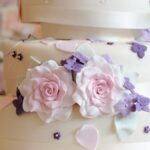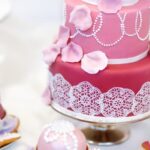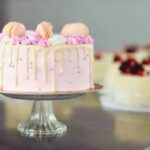Cake decorating is an art form that can truly transform a plain and simple cake into a stunning masterpiece. Whether it’s for a special occasion or just to satisfy a sweet tooth, the way a cake is decorated can make all the difference in its overall appearance.
In this article, we will explore the importance of cake decorating and how it can elevate the look of any cake, as well as provide valuable tips and techniques on how to use a cake decorator effectively.
When it comes to creating visually appealing and delicious treats, cake decorating plays a crucial role. It not only adds an aesthetic appeal to the cake but also showcases creativity and craftsmanship. From simple designs to intricate details, the right use of a cake decorator can take your baking skills to the next level and leave a lasting impression on anyone who indulges in your delectable creations.
In order to achieve professional-looking results with cake decorating, it is essential to understand the different types of decorative tools available and how they are best utilized. Additionally, selecting the right frosting and mastering various decorating techniques are key components that will be addressed in this article. So, whether you’re a beginner looking to enhance your skills or an experienced baker seeking new inspiration, understanding how to use a cake decorator is sure to elevate your baking game.
Types of Cake Decorators
Cake decorators come in various forms, each catering to different decorating needs and styles. Understanding the types of cake decorators available can help you choose the right tool for your specific project. Here are some of the most common types of cake decorators and their specific uses:
- Piping bags: Piping bags are essential for creating intricate designs and details on cakes. They can be used with different tips to achieve various patterns, such as rosettes, shells, and leaves.
- Decorating tips: There are numerous decorating tips available, each producing a different design when used with a piping bag. From star tips to round tips, understanding the various types of decorating tips is crucial for achieving your desired look.
- Icing smoother: An icing smoother is useful for achieving a smooth, professional finish on cakes. It helps create clean edges and surfaces when frosting a cake.
- Fondant tools: Fondant is a popular choice for cake decoration, and it requires specific tools for shaping, cutting, and embossing. Fondant tools include rolling pins, cutters, and texture sheets.
Understanding the uses of these different types of cake decorators is essential for achieving professional-looking results. Whether you’re a beginner or an experienced baker, knowing how to use cake decorator tools effectively can take your cake decorating skills to the next level.
Essential Tools for Cake Decorating
Cake decorating requires a variety of tools and equipment to achieve professional-looking results. Whether you’re a beginner or an experienced baker, having the essential tools for cake decorating is crucial in creating stunning and visually appealing cakes. In this section, we will detail the necessary tools and equipment needed for cake decorating, such as piping bags, tips, and spatulas.
Piping Bags and Tips
One of the most essential tools for cake decorating is a piping bag. Piping bags come in various materials such as disposable plastic or reusable cloth, and they are used to apply frosting or icing onto the cake in various designs.
Paired with different tips, piping bags can create a multitude of designs including rosettes, borders, writing, and intricate patterns. Decorating tips come in different sizes and shapes, each serving a specific purpose in creating different textures and patterns on the cake.
Spatulas and Smoothers
Spatulas are another indispensable tool in cake decorating. Offset spatulas are great for spreading frosting evenly on the surface of the cake while providing smooth edges. On the other hand, straight spatulas are perfect for filling layers with frosting and creating clean lines on the sides of the cake. Smoothers are also important to achieve that polished look on your frosted cakes; they help create perfectly straight sides and smooth surfaces on your decorated cakes.
Fondant Tools
For those who prefer working with fondant to decorate their cakes, fondant tools such as rolling pins, fondant cutters, shaping tools, and impression mats are essential. These tools help create intricate fondant decorations like flowers, ruffles, figures, or any other design you want to incorporate into your cake.
Understanding how to use these essential tools is key to successful cake decorating. When used correctly and skillfully, these tools can elevate the overall appearance of a cake. Mastering these fundamental tools will provide a strong foundation for more advanced cake decorating techniques.
Choosing the Right Frosting
When it comes to choosing the right frosting for cake decorating, it is important to consider the type of design you want to achieve and the specific techniques you will be using. Different frostings have varying textures, consistencies, and flavors, which can greatly impact the overall look and taste of your decorated cake.
One of the most common types of frosting used in cake decorating is buttercream. Buttercream is versatile and easy to work with, making it suitable for a wide range of decorating techniques such as piping borders, creating rosettes, and writing on cakes. Its creamy texture allows for smooth application and intricate detailing, making it a favorite among both beginners and experienced decorators.
For more intricate designs and detailed decorations, royal icing is often preferred. Royal icing hardens when dry, making it ideal for creating delicate flowers, lace patterns, and elaborate piping work. It also has a smooth finish when dried, giving decorations a professional look. However, due to its quick-drying nature, royal icing requires precision and speed when working with it.
Fondant is another popular choice for cake decorating, especially when creating sculpted or 3D designs. Fondant provides a polished and smooth surface that can be easily shaped and molded into various shapes and figures. It is also an excellent canvas for painting or airbrushing designs onto cakes.
| Frosting Type | Suitability |
|---|---|
| Buttercream | Versatile; suitable for piping borders, rosettes, writing |
| Royal Icing | Ideal for intricate designs such as flowers, lace patterns |
| Fondant | Great for sculpted or 3D designs; provides smooth surface for painting or airbrushing |
Before choosing a frosting for your cake decorating project, consider the specific requirements of your design and choose a frosting that best suits your needs. Each type has its own unique properties that can enhance the appearance of your cake decoration. Whether you’re aiming for simplicity or intricate elegance in your design, selecting the right frosting is crucial in achieving successful results with your cake decorator.
Basic Cake Decorating Techniques
Using a cake decorator may seem daunting at first, but with some practice and the right techniques, you can create beautiful designs on your cakes. Whether you’re looking to add rosettes, borders, or write a message on your cake, the key is to familiarize yourself with the basics of using a cake decorator.
To start, ensure that you have the necessary tools for cake decorating. This includes a piping bag, various piping tips for different designs, and an offset spatula for smoothing frosting. Once you have all your tools ready, choose a frosting that is suitable for the design you want to create. For example, buttercream is ideal for piping intricate details and writing on cakes.
When using a cake decorator to create rosettes or borders, hold the piping bag at a 90-degree angle to the surface of the cake. Apply even pressure to the bag while gently squeezing out frosting in a circular motion to create rosettes or along the edge of the cake for borders. For writing on cakes, use a small round tip and practice your cursive writing on parchment paper before attempting it directly onto the cake.
Remember that practicing these basic techniques is crucial in mastering how to use a cake decorator effectively. With time and patience, you’ll be able to create professional-looking designs on your cakes with ease.
| Basic Cake Decorating Techniques | Step-by-Step Instructions |
|---|---|
| Tools needed: piping bag, piping tips, offset spatula | Familiarize yourself with basic techniques |
| Ideal frostings: buttercream for intricate details and writing | Use proper pressure when applying frosting |
| Practice makes perfect: spend time practicing different designs | Create professional-looking designs with ease |
Advanced Cake Decorating Techniques
Once you have mastered the basic cake decorating techniques, it’s time to take your skills to the next level with more intricate and elaborate designs. With the right tools and a little practice, you can create stunning decorations such as delicate flowers, elegant ruffles, and intricate piping that will truly impress your friends and family.
Here are some advanced cake decorating techniques that will elevate your cakes to a professional level:
- Floral Designs: Using a variety of piping tips, you can create beautiful flowers such as roses, daisies, and tulips. With the right technique, these flowers will add a touch of elegance and sophistication to your cakes.
- Ruffles: Ruffles are a great way to add texture and movement to your cake designs. With the use of a petal tip or a specialty ruffle tip, you can create cascading ruffles that will give your cakes a whimsical and romantic look.
- Intricate Piping: Intricate piping designs such as lace patterns, intricate borders, and scrollwork can really take your cake decorating skills to the next level. These detailed designs require precision and patience but will undoubtedly make your cakes stand out.
With some patience and practice, you can master these advanced cake decorating techniques and create show-stopping cakes that are sure to impress. Remember to start with simple designs and gradually work your way up to more complex ones. Experiment with different tools and frosting consistencies until you find what works best for you.
As you continue to hone your skills, don’t be afraid to seek inspiration from other cake decorators or attend workshops or classes. The more techniques you learn, the better equipped you’ll be to tackle any cake decorating challenge.
Remember that advanced cake decorating takes time and dedication but the results are well worth it. Keep practicing and pushing yourself out of your comfort zone – before long, you’ll be creating stunning cakes that rival those of professional bakers.
Troubleshooting Common Issues
When using a cake decorator, it is common to encounter certain issues that can affect the overall outcome of your cake decorating process. These problems can include clogging of the piping tip, inconsistent piping, or difficulty in achieving the desired design. In this section, we will address some common problems that may arise while using a cake decorator and provide practical solutions to resolve them.
Clogging of Piping Tip
One of the most frustrating issues when using a cake decorator is experiencing clogging of the piping tip. This often occurs when working with thicker frosting or when air bubbles get trapped inside the piping bag.
To prevent clogging, it is important to use a frosting consistency that is appropriate for the design you are trying to achieve. If clogging does occur, you can try gently massaging the piping bag to remove any air bubbles or switch to a larger piping tip for smoother flow.
Inconsistent Piping
Inconsistent piping can lead to uneven and messy designs on your cake. This issue may arise from applying uneven pressure on the piping bag or using an improper technique. To ensure consistent piping, practice maintaining steady and even pressure on the piping bag while guiding it in a smooth motion. Additionally, familiarize yourself with different piping tips and their specific functions to choose the right one for your desired design.
Difficulty in Achieving Desired Design
Sometimes, despite following all instructions, you may still find it challenging to achieve your desired cake decoration design. In such cases, it is crucial to practice patience and persistence. Mastering advanced decorating techniques takes time and practice. Consider watching tutorials or taking classes to improve your skills and gain confidence in using a cake decorator effectively.
By understanding how to troubleshoot these common issues when using a cake decorator, you can overcome challenges and create beautifully decorated cakes with ease and confidence. Learning how to address these problems will ultimately enhance your overall cake decorating experience and elevate the visual appeal of your baked creations.
Tips and Tricks for Successful Cake Decorating
In conclusion, mastering the art of cake decorating can take your baking skills to the next level and create stunning, professional-looking desserts. By understanding the different types of cake decorators and essential tools needed for decorating, you can enhance the overall appearance of your cakes. Additionally, choosing the right frosting and learning basic and advanced decorating techniques will allow you to create beautiful designs and intricate patterns on your cakes.
One of the most important aspects of successful cake decorating is troubleshooting common issues that may arise while using a cake decorator. From clogging to inconsistent piping, being able to quickly address and resolve these problems will ensure that your decorating process runs smoothly. Additionally, incorporating expert tips and insider tricks into your practice will help you achieve flawless results with a cake decorator.
Frequently Asked Questions
What Does a Beginner Cake Decorator Need?
A beginner cake decorator needs a few essential tools to get started, such as a turntable, offset spatula, bench scraper, piping bags, and basic tips. These tools will help in creating smooth finishes and simple designs.
What Do You Do as a Cake Decorator?
As a cake decorator, my main responsibility is to transform plain cakes into visually appealing and delicious desserts. This involves frosting the cake with buttercream or fondant, creating intricate designs using piping techniques, and adding decorative elements like flowers or edible embellishments.
How Do You Use Cake Decorating Tips?
To use cake decorating tips effectively, it’s important to know which tip is best for creating specific designs or textures. Attach the desired tip to a piping bag filled with frosting or icing, then apply pressure while guiding the tip to create the intended design. Practice and experimentation will help improve skills in using different tips for various effects.

Welcome to my blog about home and family. This blog is a place where I will share my thoughts, ideas, and experiences related to these important topics. I am a stay-at-home mom with two young children. I hope you enjoy reading it! and may find some helpful tips and ideas that will make your home and family life even better!





